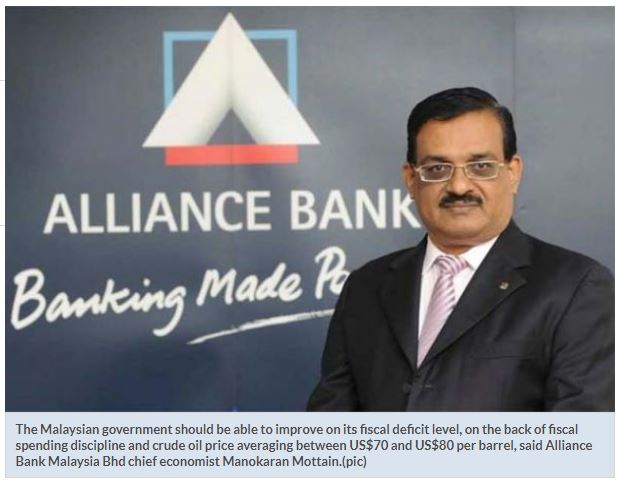Malaysia: Govt seen able to improve on its fiscal deficit level
PETALING JAYA: Expectations that the fiscal deficit level will decrease are running high on the back of rising sentiment on crude oil prices.
The Malaysian government should be able to improve on its fiscal deficit level, on the back of fiscal spending discipline and crude oil price averaging between US$70 and US$80 per barrel, said Alliance Bank Malaysia Bhd chief economist Manokaran Mottain.
The fiscal deficit guided for this year is 2.8%.
“If the government continues with its cost-cutting measures, coupled with the Brent crude oil price maintaining between US$70 and US$80 per barrel, the fiscal deficit target for 2019 could be 2.5% or lower,” he said.
Should the Brent crude oil price maintain at the current trading price of US$80 per barrel, the average crude oil price for the year would be US$70, contributing an additional revenue of US$18 per barrel when compared to the average oil price assumption of US$52 per barrel for Budget 2018.
Moving up: Operators prepare to install a bit guide on the floor of a Royal Dutch Shell Plc oil rig in Texas. Tight crude supplies, exacerbated by United States sanctions on Iran beginning Nov 4, are projected to contribute to higher prices. — Bloomberg
As each US$1 per barrel in excess will translate to RM300mil, the Malaysian government will see an additional RM5.4bil in oil revenue being added to its coffers.
Note that this does not include the additional gain from Petroliam Nasional Bhd’s dividend payout.
Tight crude supplies, exacerbated by United States sanctions on Iran beginning Nov 4, are projected to contribute to higher prices.
In addition, US crude output growth is forecast to moderate to 840,000 barrels a day.
According to the 2019 Energy, Resources & Marine Travel Forecast, US exploration and production (E&P) budgets have increased to US$132.5bil this year, up from only US$88.2bil in 2016 when oil prices crashed.
The latest Baker Hughes Rig Count reported a healthy 2,273 rigs in operation at present, the highest level since 2015 when it numbered 2,337 before plunging to 1,593 in 2016.
Meanwhile, offshore support vessel (OSV) utilisation seems to be recovering mildly from an inflection point in tandem with the global E&P capital expenditure recovery, though charter rates will likely remain low.
According to UOB KayHian, this may cause a divergence in the competitive landscape, whereby new players with strong balance sheets that acquire OSVs at low cost may have an edge over players with high cost structures.
“Global OSV utilisation has recovered to 50% to 60%, from the low of less than 50% in early 2018, likely in tandem with rising E&P activities.
“Assuming an OSV-to-rig ratio of three to five times, this also supports OSV demand.
“The average age of the global OSV fleet is approaching 14 years old, while oil and gas majors plan to employ only vessels of less than 15 years old.
“This necessitates new OSV fleet investments,” said UOB KayHian.
Source: https://www.thestar.com.my/business/business-news/2018/09/14/govt-seen-able-to-improve-on-its-fiscal-deficit-level/#KVoUMUEtxRbP6Sdo.99


 Thailand
Thailand





